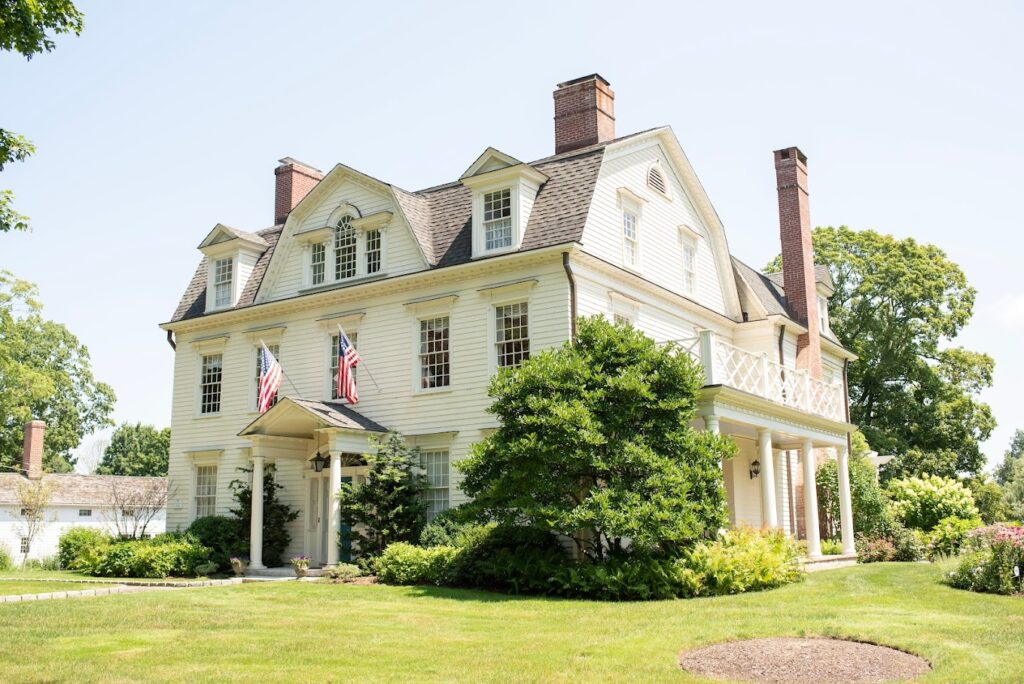The Fountain Inn

What began in the early 18th Century as a more modest structure that survived the Battle of Ridgefield later became a grand home that is now The Fountain Inn. Believed to have been built about 1740 by David Hoyt on Lot #1 of the first Proprietors’ Lots, this home-turned-inn sits at the historic intersection of Main Street and West Lane, facing the Cass Gilbert Fountain.
At the time of the Battle of Ridgefield, the David Hoyt House was home to a Tory. According to one story, when the British set fire to the tavern and home of Timothy Keeler next door, Hoyt put out the blaze — fearing the wind might spread the flames to his house. When Hoyt told Keeler that he should be thanked for saving Keeler’s home, patriot Keeler supposedly replied: “I will not thank a Tory for anything. I would rather thank the Lord for the north wind!”
The Hoyt family left Ridgefield following the war and the next owner was Thaddeus Keeler (1785-1878), a prominent businessman, whose additions and alterations created much of the house seen today. He was a longtime justice of the peace and served as a sort of lawyer. He was a selectman in 1827 and 1829, and a state representative in 1839. (He was called Squire Thad or Quality Thad to distinguish him from “Wheelwright Thad” Keeler who lived farther south of Main Street.)
Others who have lived in this home include William W. Whiting, a Yale-educated editor of The Ridgefield Press from 1882 to 1884, noted for fiery editorials about temperance issues and his support for improving public schools. Whiting married Catherine Downes in 1878, and they moved to Ridgefield soon after. He died here at the age of 28, leaving his widow with three young children, including John Downes Whiting (1884-1976), who later graduated from Yale and was a prominent illustrator, known for scenes of outdoor life and the sea.
George Henry Smillie (1840-1921), a leading American landscape artist at the turn of the 20th Century, lived and worked here. His paintings are in collections of major museums including the Metropolitan Museum of Art. Smillie’s Ridgefield scenes included a view of the historic Stebbins house shortly before it was torn down by George M. Olcott to create his Casagmo estate.
Noted French impressionist artist Paul Ullman (1906-1944), a native of France who fled the Nazis, lived at this house in the early 1940s with his wife Babette and young son. While she was active in Ridgefield raising funds for French refugees, he was recruited by the U.S. government as an underground agent with the OSS. After parachuting into France on a mission in 1944, he was killed by Gestapo agents as he fled a safehouse they were raiding. Babette Ullman Wills, who moved to California and remarried, died in 2009 at the age of 97.
Well-known physicians also occupied 114 Main Street: Dr. James Henry Inkster and Dr. Evelyn Rogers Inkster, husband and wife, lived and practiced here in the 1950s. They were followed by Dr. Henry Minot (1919-2004), a World War II Naval aviator and Harvard-educated physician, who became a thoracic surgeon who did not mind making house calls on his BMW motorcycle. When he retired in 1986, he looked for a way to help the community and saw a need for school bus drivers. He became a popular bus driver in Ridgefield and Wilton for a decade.
Families enjoyed the David Hoyt House into the 21st Century, and many young Ridgefielders were entranced by the annual Halloween scenes that greeted them over many years on Oct. 31.
Now a warm and welcoming location for visitors to RIdgefield, the Fountain Inn shines, surrounded by its beautifully tended grounds. And just opposite it, the iconic Cass Gilbert Fountain continues to greet travelers coming into Ridgefield, where Main Street and West Lane meet.
Audio Story narrated by Rob Coloney.



